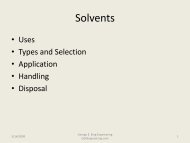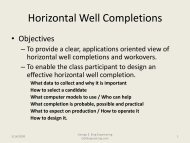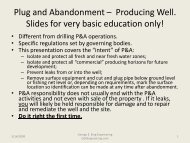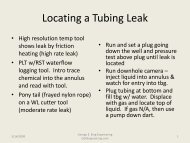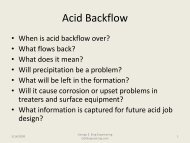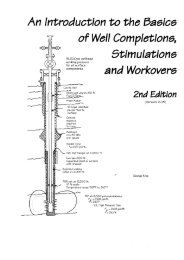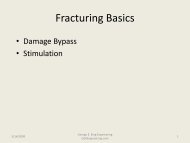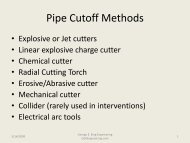Pipe Cutoff - George E King Petroleum Engineering Oil and Gas ...
Pipe Cutoff - George E King Petroleum Engineering Oil and Gas ...
Pipe Cutoff - George E King Petroleum Engineering Oil and Gas ...
- No tags were found...
Create successful ePaper yourself
Turn your PDF publications into a flip-book with our unique Google optimized e-Paper software.
8. Higher strength alloys (e.g., chrome), chemically resistant alloys, thickpipe <strong>and</strong> coatings on the inside surface of the pipe are challenges to achemical cutter. High alloy (above S-135), high chrome <strong>and</strong> nickel contentsteels, <strong>and</strong> thick wall pipe should usually not be attempted with a chemicalcutter unless all sizing, temperature <strong>and</strong> pressure conditions can be met.9. The cutter should be placed to avoid the coupling <strong>and</strong> profiles or otherjewelry.10. Deep tubing cuts (cut depth greater than 15,000 ft) are not usuallysuccessful. Pressure <strong>and</strong> temperature may be reasons.11. On reused cutters, the nozzles wash out slightly, <strong>and</strong> later cuts are muchpoorer (less focus of the fluid) than the first cut. Use a new cutter section,with gauge nozzle diameter, for best results.Some operators place some 000 <strong>and</strong> 0000 steel wool in the cutter cavity to"activate" the cutter fluid. This use may not be widespread, but field tests appearto work better than plain cutters (no steel wool),Shaped Charge Cutter – These are linear shaped charge formed into a circle.The cutters work by focusing a ultra-high pressure, directed, explosive pulseagainst the pipe wall. The cutter is a close relation to a perforating charge <strong>and</strong>are unaffected by most coatings. The draw back to an explosive cutter is theflare produced at the cut area by the detonation.Early cutters produced large flares (20% pipe diameter growth or more) <strong>and</strong>broken sections of pipe. Later cutters (last few years) have been re-engineeredto produce less than a 10% flare <strong>and</strong> no ribbons or splits.Prior to fishing operations with an overshot tool, any flare must be dressed off.
tensile force. Joints shot in this way often “jump” out with minimum application ofover-pull when shot in most API thread connections.The charge strip is held in a magnetically decentralized tool <strong>and</strong> is run onwireline. The advantage of the tool is its smaller diameter (1-11/16” <strong>and</strong> smaller)that will pass many obstructions. Tube tension during cutting is stillrecommended. The tool is best suited to upper pipe recovery operations intubing without hook-wall threads. The split coupling may hamper fishingoperations on the lower tubing.Critical Factors:1. The tool is only effective if shot in the coupling. Accurate depth control(within inches) is a must. The failures of the tool have principally beenlinked to problems in depth control. The tool can be made longer onrequest: a minimum length of 18” is suggested. Reliability is directlyproportional to depth control accuracy.2. Couplings with hook-wall threads are not good c<strong>and</strong>idates for the cutter.3. Time-at-temperature limitations of explosive powders apply.4. The problems involved with fishing a split coupling must be understoodbefore application.When shooting with the pipe in tension (above the packer) <strong>and</strong> accurate depthcontrol, the field reliability is about 90%.Abrasive Cut-off – The development of abrasive cut-off tools is an outgrowth ofthe abrasive perforating process that uses a s<strong>and</strong> <strong>and</strong> fluid slurry directed at thetubular <strong>and</strong> pumped at high rates. Tubular cut-off requires a rotating nozzle on
Critical Factors:1. Although the proper st<strong>and</strong>off from the nozzle to the tubular wall isimportant, a cut can be made with several inches of clearance.2. The tool must be anchored. If the tool can move, a large section of thepipe can be thinned without making a clean cut.3. The tool head must rotate to provide a complete cut. If the tool stalls or isrotated too long with abrasive applied to the cut, then a hole or groove canbe cut through tubing <strong>and</strong> casing.4. Back pressure increases the time needed to make the cut. Experimentalapplication of the tool in 3-1/2”, 13 lb./ft, S-135 DP has resulted in averagecut times of 3 minutes at surface conditions (about half the time neededdownhole).5. Sufficient solids must be pumped to achieve cutting. Solids may be ofvarious types, including s<strong>and</strong>, calcium carbonate <strong>and</strong> other materials.Radial Cutting Torch – The tool sprays a thermite derivative (burns at 5000F)from shaped nozzles at the wall of the tube. This device is used for higher alloytubing or cuts in jewelry. No success numbers are available, but the tool hasachieved significant reliability gains in the past several years. As shown in thefollowing photograph, application of an over lapping nozzle pattern of the materialis critical for a successful cut.The impacted surfaces are melted. Incomplete cuts <strong>and</strong> misfires have been themajor drawback, but some successes in chrome pipe have been recorded. Thecutter has few limitations, however, outside casing strings may be damaged byapplication of the cutter.
Critical Factors:1. Nozzle condition. Reuse of nozzles is not suggested due to wear.2. Nozzle to pipe wall clearance is critical to successful application of thetool.3. Crossflow <strong>and</strong> flow from outside to inside the cut surface may bedetrimental if it disperses the thermite dispersion during the cut.Mechanical cutters – These mill-like devices, rotated by tubing or downholemotors are often slow in cutting heavy wall or high alloy pipe. Tubing cut timesare 20 minutes to 6 or more hours for cutters driven by small motors, dependingon the tubing size, weight, grade <strong>and</strong> depth of cut.Critical Factors:1. Anchoring the tool is required for a successful cut.2. Good hydraulics are essential at the tool since cutting arms are pumpedout <strong>and</strong> cuttings are removed by the flow.3. Higher alloy pipes may be more difficult to cut with a mechanical cutter.Colliders– These are gross explosive tools meant to shatter or break drill collars<strong>and</strong> stabilizers. They operate by focusing a pressure surge produced by twoadvancing (<strong>and</strong> opposing) fronts of high explosive. Although seldom used innormal tubulars, they are one of the few mechanisms of cutting the heaviest walltools in a drilling BHA
This overview of pipe cutoff methods is an educational tool only <strong>and</strong> does notimply design criteria for successful application of any cutoff device.<strong>George</strong> E. <strong>King</strong>



